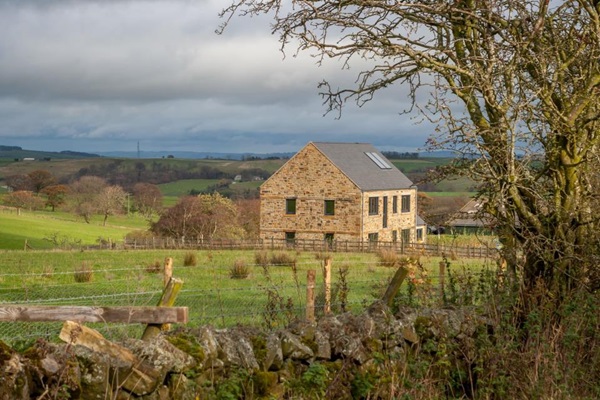A reinterpreted farmstead has become the first Certified Passivhaus in Northumberland and winner of the Small Projects Category at the 2015 Passivhaus Awards organised by the Passivhaus Trust.
Here, we take a look in more detail at Steel Farm and the rest of this year’s award nominees ...
Small Projects Category
Winner: Steel Farm, Northumberland – LEAP
Steel Farm is located near Hexham in the North Pennine Area of Outstanding Natural Beauty. Built using traditional construction technology it is a reinterpretation of the traditional Northumberland farmstead.
Materials and form were chosen to work in harmony with the region with windows proportioned and carefully positioned to act as ‘the eyes to the world’, playfully revealing views and vistas at critical moments. This nuanced design, constructed using a sensible budget, culminates in a vibrant home with a distinct sense of place.
The remote rural location, limited access to utility mains and onerous planning restrictions added significant costs to the project and have all strongly influenced the finished design.
Mark Siddall, founder of architectural practice LEAP, said: “Winning the award is testament to the ambitions of Trevor and Judith Gospel, and their heroic decision to build a low energy house in the challenging, yet beautiful, heart of rural Northumberland.”
Find out more about the Steel Farm Project 
View a free three-part video documentary series revealing how to successfully design and construct bespoke and custom self-build homes to Passivhaus standards without breaking the bank. 

Rural idyll: The Steel Farm Passivhaus
Runner-up: Dundon Passivhaus, Somerset – Prewett Bizley Architects
The Dundon Passivhaus is a detached low-energy home, built to Passivhaus Standard, nestled at the foot of a wooded hill on the edge of a Somerset Village.
By digging the lower floor into the hillside planning permission was gained for a two-storey house only marginally higher than the dilapidated 1920s bungalow it replaced.
Find out more about the Dundon Passivhaus Project

Large Projects Category
Winner: Wilkinson Primary School, Wolverhampton – Architype
A Passivhaus Primary, that takes the brief beyond necessary requirements drawing on lessons learnt on Architype’s previous work on two other Passivhaus schools – Oak Meadow and Bushbury Hill. The design addresses future needs of a 21st century learning environment with various innovations to improve performance and sustainability.
Find out more about Wilkinson Primary School Project 
Runner-up: STEM Building, Bradford – University of Bradford
A new-build multi-use lab space with associated prep rooms at the University of Bradford.
Find out more about the STEM at Bradford Project

Runner-up: Erneley Close, Manchster – R-gen
A regeneration of two dilapidated blocks of flats in one of the poorest parts of Manchester, using EnerPHit as a mechanism for creating a sustainable low-carbon community.
Find out more about Erneley Close Project

Retrofit Category
Winner: Cre8 Barn, Huddersfield – Green Building Store
A retrofit project which saw a super-insulated timber frame structure built inside an existing building to preserve the appearance of a cow byre.
Find out more about the Cre8 Barn Project

Runner-up: Admiral’s Hard, Plymouth – WARM
This project saw the conversion of a first floor flat into an EnerPHit office, and extensive retrofit of the whole building, which includes a ground floor shop.
Find out more about the Admiral’s Hard Project 
Runner-up: 11/19 Passmore Street, London – Sturgis Carbon Profiling
Two bed, historic terraced houses that achieved the first privately rented EnerPHit criteria in London. These pilot projects that have set precedence for many more to come from developers Grosvenor Britain & Ireland.
Find out more about the 11/19 Passmore Street Project

What is Passivhaus?
Passivhaus buildings are developed to deliver high levels of occupant comfort while expending little energy to heat or cool them. Developed to construction principles developed by in Germany by the Passivhaus Institute they are built with meticulous attention to detail and certified according to the Passivhaus Standard (the world’s leading quality assurance standard for low energy buildings) or the EnerPHit standard for refurb and retrofit projects.
Related resources
Passivhaus Trust

The Passivhaus Trust is an independent, non-profit organisation that provides leadership in the UK for the adoption of the Passivhaus standard and methodology.
You can follow the Passivhaus Trust awards conversation on Twitter using the hashtag: #PHTawards2015
![]()


